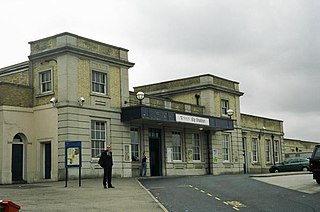
Ely railway station is on the Fen line in the east of England, serving the cathedral city of Ely, Cambridgeshire. It is 70 miles 30 chains (113.3 km) from London Liverpool Street and is situated between Waterbeach and Littleport stations on the Fen line to King's Lynn. It is an important junction for three other lines: the Ely to Peterborough Line, the Ipswich to Ely Line and the Norwich to Ely line.

King's Lynn railway station is the northern terminus of the Fen line in the east of England, serving the town of King's Lynn, Norfolk. It is 41 miles 47 chains (66.9 km) from Cambridge and 96 miles 75 chains (156.0 km) measured from London Liverpool Street.
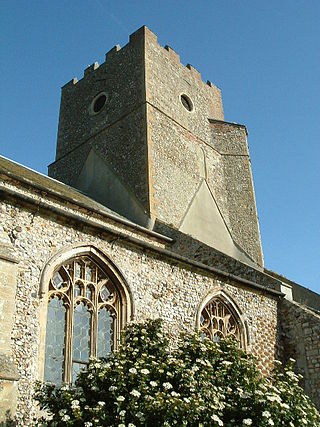
Heacham is a large village in West Norfolk, England, overlooking The Wash. It lies between King's Lynn, 14 miles (23 km) to the south, and Hunstanton, about 3 miles (4.8 km) to the north. It has been a seaside resort for over a century and a half.

The A149 is commonly known as "The Coast Road" to local residents and tourists, as this road runs along the North Norfolk coast from King's Lynn to Great Yarmouth, via coastal villages.
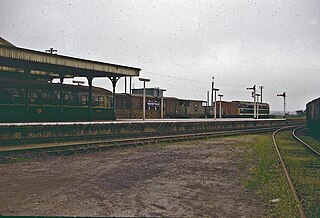
Wells-next-the-Sea railway station served the port town of Wells-next-the-Sea in North Norfolk, England. It was opened in 1857 by the Wells & Fakenham Railway, later part of the Great Eastern Railway's Wymondham to Wells branch, and became a junction in 1866 with the arrival of the West Norfolk Junction Railway. It closed in 1964.

Melton Constable was a railway station on the Midland and Great Northern Railway which served the North Norfolk village of Melton Constable from 1882 to 1964. Notwithstanding its rural location, the station became an important railway centre with lines converging from all directions providing connections to key East Anglian towns such as King's Lynn, Norwich, Cromer, Fakenham, Yarmouth and Lowestoft. Although long since demolished, there is a possibility that the station may yet be resurrected as part of the proposed Norfolk Orbital Railway.

Holkham was a railway station which served the coastal village of Holkham in Norfolk, England. Opened by the West Norfolk Junction railway in 1866, it closed with the line in 1952.
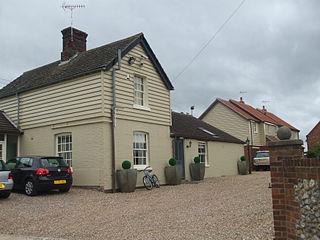
Burnham Market was a railway station which served the village of Burnham Market, Norfolk, England. Opened by the West Norfolk Junction railway in 1866, it closed with the line in 1952.

Stanhoe was a railway station which served the village of Stanhoe in Norfolk, England. Opened by the West Norfolk Junction Railway in 1866, it closed to passengers in 1952.

Sedgeford was a railway station which served the village of Sedgeford in Norfolk, England. Opened by the West Norfolk Junction Railway in 1866, passenger services ceased with the line in 1952.
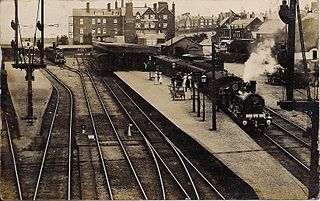
Hunstanton railway station served the seaside town of Hunstanton in Norfolk, England. Opened in 1862, the station was the northern terminus of the Lynn and Hunstanton Railway. The line was brought to public notice by John Betjeman in the British Transport Film John Betjeman Goes By Train. The station closed with the line in 1969.
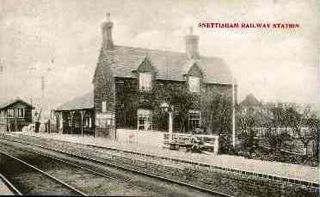
Snettisham was a railway station on the King's Lynn to Hunstanton line which served the village of Snettisham, a few miles north of King's Lynn in North Norfolk, England. Opened in 1862, the station closed along with the line in 1969.

Dersingham was a railway station on the King's Lynn to Hunstanton line which served the village of Dersingham, a few miles north of King's Lynn, in Norfolk, England.

Wolferton was a railway station on the Lynn and Hunstanton Railway line which opened in 1862 to serve the village of Wolferton in Norfolk, England. The station was also well known as the nearest station to Sandringham House, and royal trains brought the royal family to and from their estate until the station's closure in 1969.

North Wootton was a railway station on the King's Lynn to Hunstanton line which opened in 1862 to serve the village of North Wootton on the outskirts of King's Lynn in Norfolk, England. The station closed along with the line in 1969.

Railways have played an important part in the history and development of the English county of Norfolk. It currently has thirty open National Rail stations, though there were once well over a hundred.
The West Norfolk Junction Railway was a standard gauge eighteen and a half-mile single-track railway running between Wells-next-the-Sea railway station and Heacham in the English county of Norfolk. It opened in 1866 and closed in 1953. At Wells the line made a junction with the Wells and Fakenham Railway and at Heacham it connected with the line from Hunstanton to Kings Lynn.
The Lynn and Dereham Railway was a standard gauge 26+1⁄2-mile (42.6 km) single track railway running between King's Lynn and Dereham in the English county of Norfolk. The Lynn to Dereham line opened in 1846 and closed in 1968, although the section between Middleton Towers and King's Lynn remains open to freight.
The Wymondham to Wells Branch was a railway built in stages by the Norfolk Railway, Eastern Counties Railway and Wells and Fakenham Company between 1847 and 1857. The railway ran from Wymondham in the south, through Dereham and Fakenham to the coastal town of Wells-next-the-Sea; more specifically, the line ran from Wymondham South Junction, where it met the present-day Breckland Line. Passenger services along the line lasted until 1969; the railway continued to be used for freight until 1989. The southern section of the railway now forms the Mid-Norfolk Railway, with part of the northern section serving as the narrow gauge Wells and Walsingham Light Railway.

The Lynn and Hunstanton Railway was a line in Norfolk, England that opened in 1862. The railway was a major factor in developing Hunstanton as a seaside resort and residential community. The company was allied to the West Norfolk Junction Railway which built a line connecting Heacham, south of Hunstanton, to Wells-next-the-Sea that was not a financial success. The companies amalgamated in 1874 to form the Hunstanton and West Norfolk Railway, and in 1890 the company was sold to the Great Eastern Railway.


















